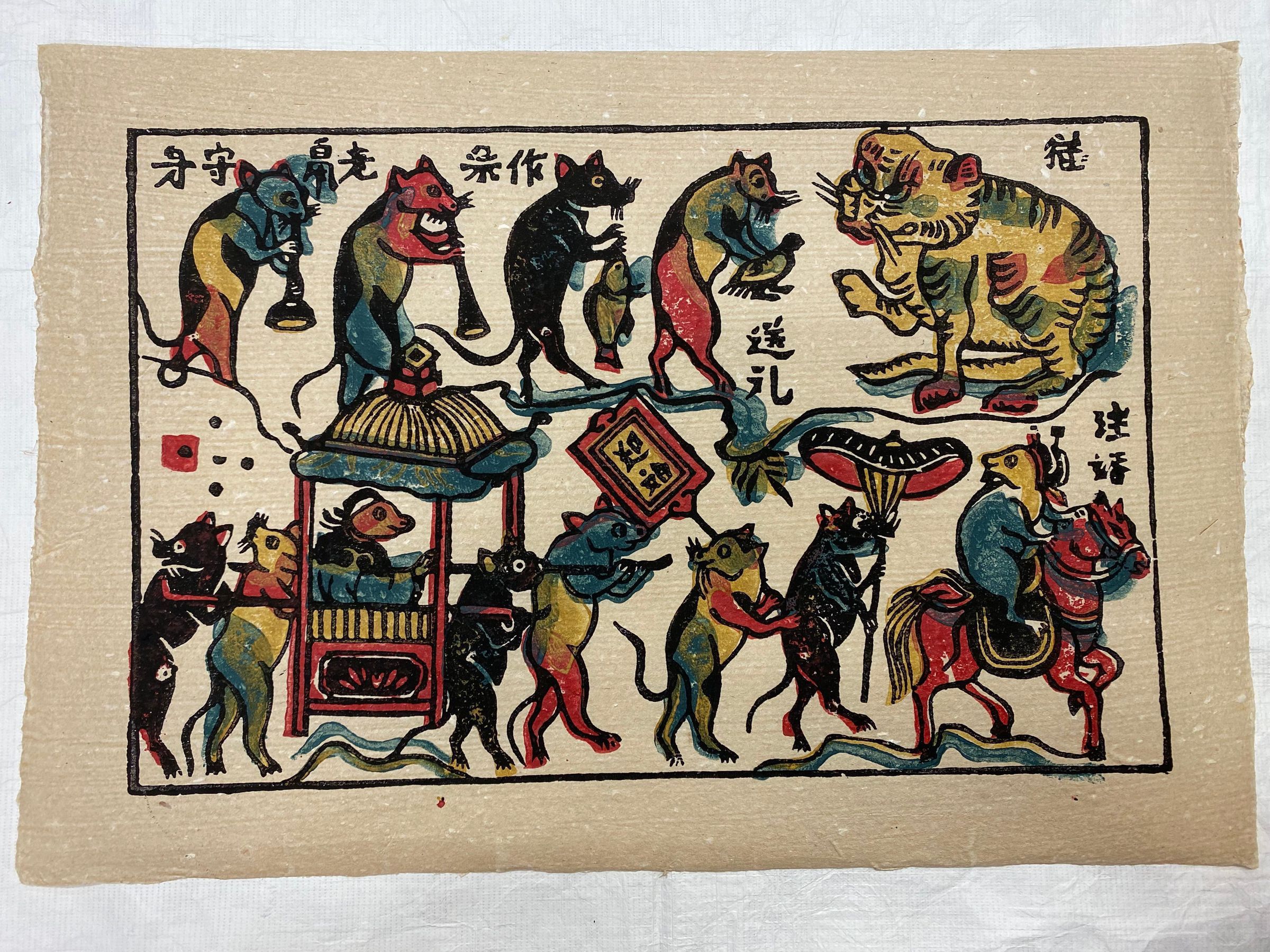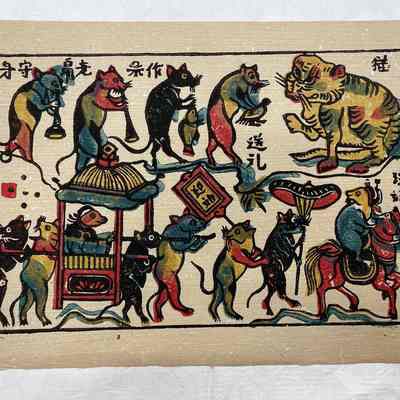Name/Title
Ðông Hồ Portfolio Đám Cưới Chuột (Rat's Wedding)Entry/Object ID
2019.P-G.078JDescription
Traditional Vietnamese folk woodblock print on plant fibrous paper horizontally depicts the story of the "mice wedding." To be read from the bottom right corner wrapping up to the top left depiction of a cat. Mice of multiple colors walk in a linear pattern in a human-like manner holding various accouterments or offerings for the cat, depicted snarling with a raised paw.Context
One of the most iconic paintings of Ðông Hồ. This painting however holds a hidden meaning in Vietnamese culture during its time as it is a satirical depiction of corruption. The Vietnamese under the Lê dynasty around the 16th century experienced significant class disparities and sufferings for the farmers under corrupted court officials and ruling class. In the Rat's Wedding, the groom sits on the horse and the bride in the palanquin, a display of the couples higher social status. Yet, offerings are still brought by the first two rats include a bird and a fish which are the cat's favorite treat to appease the cat. This may be a hint towards the relationship between Vietnam and China during the Lê dynasty when the Vietnamese king and high ranking officials had to regularly send gifts to the Chinese emperor to express their loyalty and support. Farmers, represented by the accompanying fearful rats, were expected to go along having no say in the matter. Under the guise of a joyful wedding procession, Ðông Hồ artists were able to subtly express the discontentment of the farmers with their corrupted rulers.
The Rat's Wedding is also a very popular fable known across Asia. It is a story of ambitious parents trying find the most powerful match for their precious daughter to wed. At first the parents go to the Sun but the Sun admits to defeat when the Cloud covers its rays. The Cloud is defeated, blown away by the Wind, but the Wind is also no match to the Wall. At the end, it is the small rat that defeats the Wall by digging a hole into it and ends up marrying the daughter.
From insert in boxset about series, directly transcribed:
A Brief Overview of "Ðông Hồ" Folk Paintings:
The "Dong Ho" folk paintings have been around for nearly 500 years. The themes of these paintings were inspired by everyday life and created by artisans' observations and experiences.
The main themes include:
Congratulatory paintings, which reflect the common wishes of people: a happy family, longevity, wealth, and prosperity, as seen in paintings such as Phú Quý (Wealth and Nobility), Vinh Hoa (Glory), Gà Đàn (Hen and Chicks), Lợn Đàn (Pigs).
Paintings depicting festivals and traditional activities, such as wrestling contests, drum carrying, buffalo fighting, as well as daily life scenes like đánh ghen (a fight between women over a man), hứng dừa (picking coconuts), thầy đồ cóc (the frog teacher), đám cưới chuột (a mouse wedding), and folklore stories such as Trê Cóc Kiện Nhau (Catfish and Frog Suing Each Other), Đinh Bộ Lĩnh (founding emperor of the short-lived Đinh dynasty), and Bà Triệu (legendary Vietnamese heroine).
Over many generations, artisans creatively used available local materials to craft these artworks.
Initially, the images were carved onto wood, usually wood from the thị tree, thừng mực wood, or vàng tâm wood. These carvings were then printed onto dó paper, which had been coated with a special resin. Dó paper is handmade from the bark of the dó tree, while the resin is made from the shells of dead mollusks, cleaned, crushed, and mixed with rice paste. The mixture was applied to the paper with a brush made from dry pine leaves, creating the texture that gives the painting life.
The artisans used only a few natural materials to create the colors: red from clay, green from tràm leaves or copper rust, white from diệp powder, yellow from the hoè tree flowers, and black from ash made from bamboo leaves or rice straw.
The patterns were carefully printed and harmoniously arranged, creating a unique identity. In the rich collection of Vietnamese folk art, the "Dong Ho" paintings stand out as a distinct form of expression, originating from the village of Song Ho in Thuận Thành district, Bắc Ninh province.Collection
Palmeri-Goodstein Research Print CollectionMade/Created
Artist Information
Artist
Tranh Dan GianRole
ArtistEthnography
Cultural Region
* Untyped Cultural Region
VietnamLexicon
Search Terms
Longevity, Life, Abundance, Wealth, Luck, Prosperity, Nature, Symbolic, Allegory, Happy marriage, Husband, Wife, Bride, Feline, MouseDimensions
Height
10-1/8 inHeight
8 inWidth
12-1/2 in
